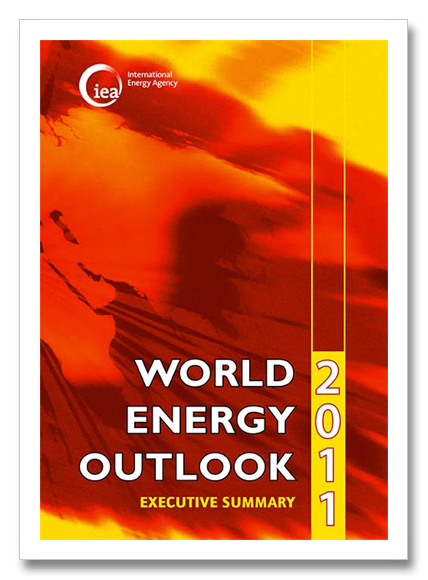The International Energy Agency (IEA) has returned a valuable yet frightening assessment of our current and future energy use and climate change. We have just five years to bring our energy sources into line with climate change mitigation scenarios or we default on our planet. Says the IEA: “On planned policies, rising fossil energy use will lead to irreversible and potentially catastrophic climate change.”
The IEA was created in 1973 after the world oil crisis. Their mission was meet world energy knowledge and policy needs in the future so as to manage for things like the 1973 oil crisis. The Agency broadened its mandate to focus on the 3Es of sound energy policy: energy security, economic development, and environmental protection.
IEA Ministers say “Current energy trends are not sustainable and a better balance must be found between the three Es. Energy is part of many environmental problems, including climate change, and must be part of the solution. The IEA has been engaged for more than a decade on designing cost-effective approaches to reduce CO2 emissions, from the international policy architecture (including trading mechanisms) to energy efficiency policy and the promotion of clean technologies.”
What the IEA says reveals a more aware evaluation of global energy issues than is customary for this organization: “The window of opportunity is closing … Governments need to introduce stronger measures to drive investment in efficient and low-carbon technologies. [Remember, this is the IEA, famous for fossil fuels.] Faith Birol, IEA Chief Economist is quoted in the press release: “As each year passes without clear signals to drive investment in clean energy, the „lock-in of high-carbon infrastructure is making it harder and more expensive to meet our energy security and climate goals.”
The 660 page World Energy Outlook 2011 is the flagship publication of the IEA.
Faith Birol, IEA Chief Economist says: “As each year passes without clear signals to drive investment in clean energy, the lock-in of high-carbon infrastructure is making it harder and more expensive to meet our energy security and climate goals.” What Ms. Birol is telling us is that if we continue with business as usual energy usage, when 2017 rolls around CO2 levels in our atmosphere will rise to 450 ppm regardless of other actions we take and 2 degrees of warming will be guaranteed.
There is good news and bad with this evaluation. There is time to act. Some international commitments do allow for reductions in our emissions but as of now, agreement and ratification by many of the most important countries is unlikely to happen in the next several years.
More good news: The technologies to reduce emissions exist now. New technologies have been proven in the lab and rapid implementation is completely economical relative to the cost of inaction. But the motivation of our leaders is lacking.
The IEA relies on a 450 ppm scenario. This path calls for allowable emissions demonstrated to meet the globally agreed upon goal of limiting the temperature rise to 2°C. Four-fifths of the total energy-related CO2 emissions allowed by 2035 are already locked-in by existing investments including power stations, transportation, buildings and factories. Continuing with business as usual means that by 2017, the energy-related infrastructure then in place would generate all the CO2 emissions allowed in the 450 Scenario up to 2035.
The big problem here is that much of the latest science now tells us that 350 ppm is the maximum CO2 concentration we can reach before experiencing 2 degrees C. of warming. We have already experienced 1.4 degrees and between and 0.8 degrees (depending on the study) of warming will occur because of emissions already made. Our CO2 concentration when these reports were made was a little over 380 pm. You do the math.
More concerning, there is a growing position that 1 degree C represents the threshold to “dangerous climate change.” This represents 300 ppm CO2 or 350 ppm CO2″e”, which takes into account warming from non-CO2 greenhouse gases.
More good news (even though at first glance this appears to be anything but good news.) The report tells us: “Delaying action is a false economy: For every $1 of investment in cleaner technology that is avoided in the power sector before 2020, an additional $4.30 would need to be spent after 2020 to compensate for the increased emissions.” In other words, from the 2009 IEA report: “The world will have to spend an extra $500 billion to cut carbon emissions for each year it delays implementing a major assault on global warming.” So where is the good news here? Start now. These costs figures represent about 1 percent of global annual Gross Domestic Product (GDP). In 2010 Global GDP was $63 trillion. One percent of this amount is $630 billion, a little more than the IEA estimate it will cost to mitigate for the delayed costs per year.
The really good news here, did you catch my math error? The IEA says that it will cost $500 billion per year after 2020. Up until then, $1 dollar spent avoids $4.30 cents after 2020. In other words, what we spend in the next nine years is discounted by over 75 percent! Lets get busy!
Report: http://www.worldenergyoutlook.org/
Press Release: http://www.worldenergyoutlook.org/docs/weo2011/pressrelease.pdf

